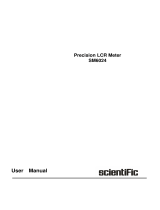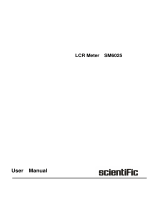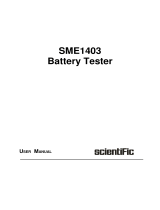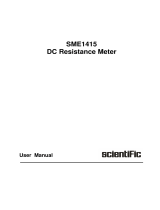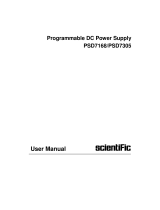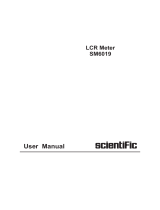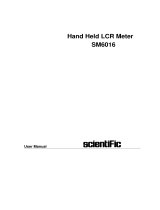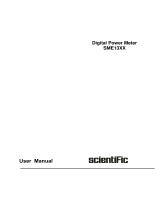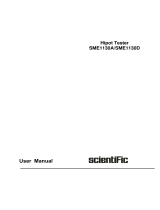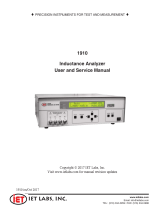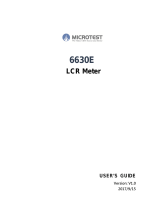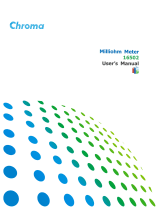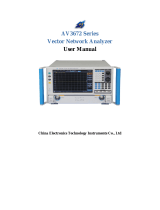Page is loading ...

O
OP
PE
ER
RA
AT
TI
IO
ON
N
M
MA
AN
NU
UA
AL
L
SM6028 Series
Precision LCR Meter
User Manual

Scientific
SM6028
2/143
Copyright © Scientific All rights reserved.
This instrument contains proprietary information, no part of this manual may be
photocopied, reproduced or translated without any prior written consent.
Information in this manual supercede all corresponding previous released material.
Scientific continues to improve products and reserves rights to amend part or all of the
specifications, procedures, equipment at any time without notice.
Rev 1.0/ 0321

Scientific
SM6028
3/143
Contents
Chapter 1 Overview ...................................................................................................................... 8
1.1 To Inspect the package ................................................................................................. 8
1.2 Power connection ......................................................................................................... 8
1.3 Fuse .............................................................................................................................. 8
1.4 Environment ................................................................................................................. 8
1.5 Use of Test Fixture ....................................................................................................... 9
1.6 Warm-up ....................................................................................................................... 9
1.7 Other features ............................................................................................................... 9
Chapter 2 Introduction ................................................................................................................ 10
2.1 Introduction to front panel.......................................................................................... 10
2.2 Introduction to rear panel ........................................................................................... 12
2.3 Introduction to display zone ....................................................................................... 13
2.4 Main menu keys and corresponding displayed pages ................................................ 14
2.4.1 [DISP] ................................................................................................................ 14
2.4.2 [SETUP] ............................................................................................................. 14
2.4.3 [SYSTEM] ......................................................................................................... 14
2.5 Basic Operation .......................................................................................................... 14
2.6 Start the instrument .................................................................................................... 15
Chapter 3 Introduction to [DISP] ................................................................................................ 16
3.1 <MEAS DISPLAY> ................................................................................................... 16
3.1.1 Test function ....................................................................................................... 17
3.1.2 AC Test range ..................................................................................................... 19
3.1.3 Test frequency .................................................................................................... 19
3.1.4 AC Test level ...................................................................................................... 20
3.1.5 DC bias ............................................................................................................... 21
3.1.6 Test speed ........................................................................................................... 22
3.1.7 DC Source .......................................................................................................... 23
3.1.8 Tools ................................................................................................................... 23
3.2 <BIN NO. DISP> ....................................................................................................... 24
3.2.1 Comparator function .......................................................................................... 25
3.3 <BIN COUNT DISP> ................................................................................................ 25
3.3.1 PARAM .............................................................................................................. 26
3.3.2 NOM. ................................................................................................................. 26
3.3.3 BIN ..................................................................................................................... 26
3.3.4 HIGH/LOW ........................................................................................................ 27
3.3.5 COUNT .............................................................................................................. 27
3.3.6 AUX ................................................................................................................... 27
3.3.7 OUT ................................................................................................................... 27
3.4 <LIST SWEEP DISP> ............................................................................................... 27
3.4.1 Sweep mode ....................................................................................................... 28
3.4.2 FREQ (Hz) ......................................................................................................... 29
3.4.3 R[:] X[: ] .......................................................................................................... 29

Scientific
SM6028
4/143
3.4.4 CMP (Compare) ................................................................................................. 29
3.5 <TRACE SWEEP> .................................................................................................... 29
3.5.1 FORMAT............................................................................................................ 30
3.5.2 SCALE ............................................................................................................... 30
3.5.3 READ ................................................................................................................. 30
3.5.4 TRACE ............................................................................................................... 31
3.5.5 POINTS .............................................................................................................. 31
3.5.6 TRIGGER .......................................................................................................... 31
3.5.7 SAVE CSV & SAVE AS .................................................................................... 31
3.6 <MEAS SETUP> ....................................................................................................... 32
3.6.1 Trigger mode ...................................................................................................... 34
3.6.2 Auto level control function ................................................................................ 34
3.6.3 Bias current isolation function ........................................................................... 35
3.6.4 Average .............................................................................................................. 35
3.6.5 DC Bias Level monitor function ........................................................................ 36
3.6.6 Trigger Delay ..................................................................................................... 36
3.6.7 Step Delay .......................................................................................................... 36
3.6.8 DCI Range .......................................................................................................... 37
3.6.9 DC Level ............................................................................................................ 38
3.6.10 DC Range ........................................................................................................... 38
3.6.11 Bias polarity ....................................................................................................... 39
3.6.12 Deviation test function ....................................................................................... 40
3.7 <CORRECTION> ...................................................................................................... 41
3.7.1 OPEN ................................................................................................................. 42
3.7.2 SHORT ............................................................................................................... 43
3.7.3 LOAD ................................................................................................................. 45
3.7.4 Load correction test function .............................................................................. 46
3.7.5 Single-point correction ....................................................................................... 46
3.7.6 Clear correction data .......................................................................................... 47
3.7.7 Cable length selection ........................................................................................ 47
3.8 <LIMIT TABLE> ....................................................................................................... 47
3.8.1 Swap parameter .................................................................................................. 48
3.8.2 Limit modes of compare function ...................................................................... 49
3.8.3 Set nominal value of tolerance mode ................................................................. 50
3.8.4 Comparator function ON/OFF ........................................................................... 50
3.8.5 Auxiliary bin ON/OFF ....................................................................................... 50
3.8.6 HIGH/LOW ........................................................................................................ 51
3.9 <LIST SWEEP SETUP> ............................................................................................ 52
3.9.1 MODE ................................................................................................................ 53
3.9.2 Test parameter .................................................................................................... 53
3.9.3 Sweep parameter setup ....................................................................................... 53
3.10 TRACE SWEEP SETUP............................................................................................ 54
3.10.1 Function.............................................................................................................. 54
3.10.2 Level ................................................................................................................... 55

Scientific
SM6028
5/143
3.10.3 DC Bias .............................................................................................................. 55
3.10.4 Trace ................................................................................................................... 55
3.10.5 Range ................................................................................................................. 55
3.10.6 Scale ................................................................................................................... 55
3.10.7 Frequency ........................................................................................................... 55
3.10.8 Speed .................................................................................................................. 55
3.10.9 Format ................................................................................................................ 55
3.10.10 Trigger ................................................................................................................ 56
3.10.11 Mode .................................................................................................................. 56
3.10.12 Start delay ........................................................................................................... 56
3.10.13 Point ................................................................................................................... 56
3.10.14 Step delay ........................................................................................................... 56
3.10.15 Maximum and minimum .................................................................................... 56
3.10.16 START ................................................................................................................ 56
3.10.17 END ................................................................................................................... 56
3.10.18 Coordination range settiing ................................................................................ 57
Chapter 4 [SYSTEM] and <FILE MANAGE> .......................................................................... 58
4.1 <SYSTEM SETUP> .................................................................................................. 58
4.1.1 MAIN FUNC ..................................................................................................... 58
4.1.2 KEY SOUND ..................................................................................................... 58
4.1.3 PASS BEEP ........................................................................................................ 59
4.1.4 FAIL BEEP......................................................................................................... 59
4.1.5 LANGUAGE ...................................................................................................... 59
4.1.6 PASS WORD ..................................................................................................... 60
4.1.7 BUS MODE ....................................................................................................... 60
4.1.8 GPIB ADDR ....................................................................................................... 60
4.1.9 TALK ONLY ...................................................................................................... 61
4.1.10 BIAS SRC .......................................................................................................... 61
4.1.11 BAUD RATE ..................................................................................................... 61
4.1.12 DATA/TIME ....................................................................................................... 62
4.2 LCR <FILE MANAGE> ............................................................................................ 62
4.2.1 Setup file for single-group component (*.STA) ................................................. 62
4.2.2 U-disk manage performance .............................................................................. 63
4.2.3 Operation steps for file management.................................................................. 64
Chapter 5 Execute LCR operation and some examples .............................................................. 66
5.1 Correction operation ................................................................................................... 66
5.1.1 Sweep correction ................................................................................................ 66
5.1.2 Point-frequency correction ................................................................................. 66
5.2 Correct connection of DUT ........................................................................................ 67
5.3 Eliminate the influence of stray impedance ............................................................... 68
5.4 Operation example for testing inductance with SM6028 ........................................... 69
5.5 Operation example of testing capacitance by multi-frequency list sweep ................. 70
5.6 Setup example of comparator ..................................................................................... 72
5.6.1 Capacitor sorting ................................................................................................ 72

Scientific
SM6028
6/143
5.7 Operation example of load correction ........................................................................ 73
Chapter 6 Performance and Test ................................................................................................. 75
6.1 Test function ............................................................................................................... 75
6.1.1 Parameter and symbol ........................................................................................ 75
6.1.2 Equivalent mode ................................................................................................. 75
6.1.3 Range ................................................................................................................. 75
6.1.4 Trigger ................................................................................................................ 75
6.1.5 Delay time .......................................................................................................... 75
6.1.6 Connection modes of test terminals ................................................................... 76
6.1.7 Test speed (Frequency>=10kHz)........................................................................ 76
6.1.8 Average .............................................................................................................. 76
6.1.9 Display digit ....................................................................................................... 76
6.2 Test signal ................................................................................................................... 76
6.2.1 Test signal frequency .......................................................................................... 76
6.2.2 Signal mode ........................................................................................................ 76
6.2.3 Test signal level .................................................................................................. 77
6.2.4 Output impedance .............................................................................................. 77
6.2.5 Monitor for test signal level ............................................................................... 77
6.2.6 Maximum measurement display range ............................................................... 77
6.2.7 DC bias voltage source ....................................................................................... 77
6.3 Measurement accuracy ............................................................................................... 78
6.3.1 Z,Y, L, C, R, X, G, B accuracies ............................................................. 78
6.3.2 D accuracy .......................................................................................................... 78
6.3.3 Q accuracy .......................................................................................................... 78
6.3.4 Θ accuracy .......................................................................................................... 79
6.3.5 G accuracy .......................................................................................................... 79
6.3.6 Rp accuracy ........................................................................................................ 79
6.3.7 Rs accuracy ........................................................................................................ 80
6.3.8 Accuracy factor .................................................................................................. 81
6.3.9 DCR accuracy .................................................................................................... 85
6.3.10 Test time ............................................................................................................. 85
6.4 Safety requirement ..................................................................................................... 85
6.4.1 Insulation resistance ........................................................................................... 85
6.4.2 Insulation intensity ............................................................................................. 85
6.4.3 Leakage current .................................................................................................. 85
6.5 Electromagnetic compatibility ................................................................................... 85
6.6 Performance test ......................................................................................................... 86
6.6.1 Working condition .............................................................................................. 86
6.6.2 The used instruments and devices ...................................................................... 86
6.6.3 Function check ................................................................................................... 87
6.6.4 Test signal level .................................................................................................. 87
6.6.5 Frequency ........................................................................................................... 87
6.6.6 Measurement accuracy ....................................................................................... 87
6.6.7 Accuracy of C and D .......................................................................................... 87

Scientific
SM6028
7/143
6.6.8 Accuracy of L ..................................................................................................... 87
6.6.9 Accuracy of Z ..................................................................................................... 88
6.6.10 Accuracy of DCR ............................................................................................... 88
Chapter 7 Command Reference .................................................................................................. 89
7.1 Subsystem commands for SM6028 ............................................................................ 89
7.1.1 DISPlay subsystem commands .......................................................................... 89
7.1.2 FREQuency subsystem commands .................................................................... 91
7.1.3 VOLTage subsystem commands ........................................................................ 92
7.1.4 CURRent subsystem commands ........................................................................ 92
7.1.5 AMPLitude subsystem commands ..................................................................... 93
7.1.6 OUTPut subsystem commands .......................................................................... 93
7.1.7 BIAS subsystem commands ............................................................................... 94
7.1.8 FUNCtion subsystem commands ....................................................................... 95
7.1.9 LIST subsystem commands.............................................................................. 101
7.1.10 APERture subsystem commands...................................................................... 104
7.1.11 TRIGger subsystem commands ....................................................................... 104
7.1.12 FETCh? subsystem commands ........................................................................ 106
7.1.13 CORRection subsystem commands ................................................................. 108
7.1.14 COMParator subsystem commands ................................................................. 113
7.1.15 Mass MEMory subsystem commands .............................................................. 118
7.1.16 TRAN subsystem commands ........................................................................... 118
7.2 GPIB Common Commands ...................................................................................... 127
Chapter 8 Description for Handler ............................................................................................ 131
8.1 Technology description ............................................................................................ 131
8.2 Operation description ............................................................................................... 131
8.2.1 Introduction ...................................................................................................... 131
8.2.2 The definition for the signal line ...................................................................... 131
8.2.3 Electrical feature .............................................................................................. 138
8.2.4 Handler interface board circuit ......................................................................... 139
8.2.5 Operation .......................................................................................................... 141
Chapter 9 Service and Maintenance ......................................................................................... 142
Chapter 10 Warranty ................................................................................................................... 143

Scientific
SM6028
8/143
Chapter 1 Overview
When you receive the instrument, some inspections are necessary, and the condition must be
understood and available before installing the instrument.
1.1
To Inspect the package
Inspect the shipping container for damage after unpacking it. It is not recommended to power on
the instrument in the case of a damaged container.
If the contents in the container do not conform to the packing list, notify us or your dealer.
1.2
Power connection
1) Power-supplying voltage range: 100~120Vac or 198~242Vac. Being related with the power
setup on the rear panel.
2) Power-supplying frequency range: 47~63Hz.
3) Power-supplying power range: less than 80VA.
4) Power supplying input phase line L, zero line N, ground lead E should be as same as the
power plug of the instrument.
5) After careful design, the instrument can reduce the clutter jamming caused by AC power
terminal input, however, it should be used under the environment with low-noise. Please
install power filter if being unavoidable.
———————————————————————————————————————
Warning: In order to prevent user and instrument from being hurt by leakage, it is necessary
for user to guarantee the ground line of supply power being reliably grounded.
———————————————————————————————————————
1.3
Fuse
The instrument has installed fuse, so operators should use the installed fuse of our company.
———————————————————————————————————————
Warning: Be sure that the location of fuse is consistent with power-supplying voltage range
before charging.
———————————————————————————————————————
1.4
Environment
1) Please do not operate the instrument in the place that is vibrative, dusty, under direct sunlight

Scientific
SM6028
9/143
or where there is corrosive air.
2) The normal working temperature is 0℃40℃, relative humidity ≤75%, so the instrument
should be used under above condition to guarantee the accuracy.
3) There is heat abstractor on the rear panel to avoid the inner temperature rising. In order to keep
good airiness, please don’t obstruct the left and right airiness holes to make the instrument
maintain the accuracy.
4) Although the instrument has been specially designed for reducing the noise caused by ac
power, a place with low noise is still recommended. If this cannot be arranged, please make
sure to use power filter for the instrument.
5) Please store the instrument in the place where temperature is between 5℃ and 40℃, humidity
is less than 85%RH. If the instrument will not be put in use for a time, please have it properly
packed with its original box or a similar box for storing.
6) The instrument, especially the test cable should be far from strong electro-magnetic field, to
avoid the jamming on measurement.
1.5
Use of Test Fixture
Please use the accessory test fixture or cable, the test fixture made by user or from other
company may cause the incorrect measurement result. The test fixture or cable should be kept
clean, as well as the pin of DUT, thus to guarantee the good connection between DUT and fixture.
Connect the fixture or cable to four test terminals Hcur, Hpot, Lcur, Lpot on the front panel. As for
the DUT with shielding shell, connect shielding layer or ground “”.
Note: When test fixture or cable has not being installed, the instrument will display an unstable test
result.
1.6
Warm-up
1) To guarantee the accurate measurement, the warm-up time is no less than 15min.
2) Please not turn on or off instrument frequently, in order to avoid the inner data fluster.
1.7
Other features
1) Power: consumption power≤80VA.
2) Dimension (W*H*D): 400mm*132mm*385mm
3) Weight: About 13kg.

Scientific
SM6028
10/143
Chapter 2 Introduction
In this chapter, the basic operation features of SM6028 series are described. Please read the content
carefully before using SM6028 series instruments, thus you can learn the operation of SM6028.
2.1
Introduction to front panel
Figure 2-1 shows the front panel of SM6028.
Figure 2-1 Front panel
1) USB HOST interface
Connect U flash disk so as to save or use a specified file.
2) [KEYLOCK]
Press [KEYLOCK], it will be lighted, which means the function of current panel is locked.
Press it again, it will be off, which means discharging the lock status. If the password function
is ON, it means correct password is necessary when discharging the key-lock, or the key
cannot be unlocked.
When the instrument is controlled by RS232, [KEYLOCK] will be lighted. Press it again, it
will be off, which means discharging the lock status.
3) [DC BIAS]
[DC BIAS] is used to permit or forbid the output of DC bias source. Press this key, it will be
lighted which means DC bias output is permitted. Press this key once more, it will be off
which means DC bias output is prohibited. The key is useless in some pages where the DC
BIAS cannot be added.
4) [DC SOURCE]
It is the function of DC voltage source (-10~+10V). It can extend the flexibility of DC control
and biasing through independent output of DC source port. For example, it can be used for
measurement of three-port devices.
5) Brand and model
Brand and model
6) LCD
800*480 colorful TFT LCD display, showing the measurement results and conditions
7) [COPY]

Scientific
SM6028
11/143
Copy the currently displayed page to USB memory.
8) [DISP]
Press this key to enter into the corresponding test display page.
9) [SETUP]
Press this key to enter into the corresponding test setup page.
10) [SYSTEM]
Press this key to enter into the system setup page.
11) Numerical keys
These keys are used to input data to the instrument. The key consists of numerical keys [0] to
[9], decimal point [.] and [+/-] key.
12) [ESC]
ESCAPE key
13) [←]
BACKSPACE key is used to delete the last numeric of the input value.
14) [CAL]
Reserved function.
15) Knob with confirmation function
Move the cursor to select and set the parameters. The middle confirmation button is used to
terminate the data input, confirm and save the data entered by the knob.
16) [TRIGGER]
When the trigger mode is set to MAN mode, press this key to trigger the instrument.
17) [RESET]
Press the [RESET] button to end the scan only during automatic scanning and any operation
cannot be executed on other pages.
18) [ENTER]
This key is used to end the input of data, and confirm and save the data displayed on the
inputting line (the bottom line on LCD).
19) Test terminals (UNKNOWN)
4-teminal test pair are used to connect 4-terminal test fixture or cable to measure DUT.
The 4 terminals are respectively as follows: Hcur, Hpot, Lpot and Lcur.
DC power output end (DC SOURCE)
20) PASS / FAIL indicator
LED indicator shows the test result has passed or failed.
21) CURSOR
Four cursor keys are used to move the cursor between the fields and fields of the LCD display
page. When the cursor moves to a field, the field is highlighted on the LCD.
22) Jump button
It enables the cursor to jump quickly between different fields.
23) Ground terminal
The ground terminal is connected with the case of instrument, which can be used to protect or
shield the ground connection.
24) FILE
This key is used to enter into FILE MANAGE interface.
25) Soft keys

Scientific
SM6028
12/143
Six softkeys are available for selecting controls and parameters, and the left side of each
softkey has a corresponding function definition. Softkey definitions vary depending on the
display page.
26) POWER
Power switch
2.2
Introduction to rear panel
Figure 2-2 shows the rear panel of SM6028.
Figure 2-2 Rear panel
1) LAN interface
LAN interface is used to realize the control and the communication of network system.
2) USB DEVICE interface
The tester can communicate with PC through the USB DEVICE interface.
3) IEEE-488 interface
The tester can communicate with PC through GPIB interface.
4) TRIGGER interface
External trigger device such as foot control can be connected.
5) Nameplate
Information about production date, instrument serial number and manufacturer etc..
6) RS232 interface
Series communication interface can realize the communication with PC.
7) SCANNER interface
SCANNER interface (reserved).
8) Temperature measurement interface
Interface for temperature measurement (reserved).
9) HANDLER interface
Handler interface is used to realize the sorting output of test results.
10) Fan window
Heat elimination, maintaining the normal working temperature.
11) Power socket
Input AC power.
12) Fuse base
Being used to install power fuse, protect instrument, and switch 110V/220V by changing the

Scientific
SM6028
13/143
direction of core.
———————————————————————————————————————
Warning: Be sure that the direction of fuse is accordant with power-supply voltage range
before charging.
———————————————————————————————————————
13) Ground terminal
The ground terminal is connected with instrument casing, being available for protecting or
shielding ground connection.
2.3
Introduction to display zone
SM6028 applies a 65k, 7-inch TFT display. The display screen is divided into the following zones:
1) Display page name
Indicate the name of the currently displayed page.
2) Soft keys
The zone is used to display the function definition of soft key. The definition of soft key can
be different as the difference of cursor’s direction in the zone.
3) Test result/ condition display zone
In this zone, test result information and current condition are displayed.
4) Help
In this zone, information about system and user data input is displayed.

Scientific
SM6028
14/143
2.4
Main menu keys and corresponding displayed pages
2.4.1 [DISP]
When the LCR function is active, press this key-[DISP] to enter into the LCR measurement display
page, the following soft keys will be displayed in the soft key zone.
<MEAS DISPLAY>
<BIN NO.>
<BIN COUNT>
<LIST SWEEP>
<TRACE SWEEP>
<SAVE LOG>
2.4.2 [SETUP]
When the LCR function is active, press this key-[SETUP], the following soft keys will be
displayed in the soft key zone on the LCR measurement setup page.
<MEAS SETUP>
<CORRECTION>
<LIMIT TABLE>
<LIST SETUP>
<TRACE SETUP>
<TOOLS>
2.4.3 [SYSTEM]
This key-[SYSTEM] is used to enter into the system setup page. The following soft keys will be
available:
<SYSTEM SETUP>
<LAN SETUP>
<HANDLER SETUP>
<CHANNEL SETUP>
< DEFAULT SETTINGS>
<SYSTEM RESET>
2.5
Basic Operation
Basic operation of SM6028 is as follows:
Use menu keys ([DISP], SETUP], [SYSTEM]) and soft keys to select the desired page.
Use cursor keys ( ) to move the cursor to the desired zone. When the
cursor moves to a specified zone, this zone will be highlighted to change the background color

Scientific
SM6028
15/143
display. A zone is an area where values can be set or changed.
When the knob is in the non-input state, clockwise and anticlockwise direction correspond
respectively the function of the [ ] and [ ] key. The confirmation button in the middle of the
knob can be used for input and non-input status at the position where the cursor can be
changed. When in input state, the clockwise and counterclockwise directions of the knob can
be used to switch the data of the cursor position.
The soft key functions corresponding to the current zone of the cursor will be displayed in the
soft key zone. Users can select and use the desired key. Numeric keys, [ ] and [ENTER] are
used to input data.
When a numeric key is pressed down, the usable unit soft key will be displayed in the soft key
zone. You can choose a unit soft key or press [ENTER] to end data inputting. When [ENTER]
is used to terminate data inputting, the unit of data will be set to a default unit, such as Hz, V
or A. For example, the default unit for frequency is Hz.
2.6
Start the instrument
Plug in 3-line power plug.
Caution: Keep the power-supply voltage and frequency conform to above specifications. Power
input phase line L, zero line N, ground line E should be the same as that of the instrument.
Press the power switch at the left corner on the front panel and then a boot screen will appear which
displays our company logo, instrument model and the version number of the software.
If the password protection function is on, users are required to input the password and then press
[ENTER] to enter into the page of main menu.
———————————————————————————————————————
Note: The instrument has a default password-2838. In your practical use, you can change it and set
your own one. Please see <SYSTEM> section for more information.

Scientific
SM6028
16/143
Chapter 3 Introduction to [DISP]
3.1
<MEAS DISPLAY>
Press [DISP], the <MEAS DISPLAY> page will be displayed on screen as shown in the following
figure.
On this page, the test result is displayed in upper-case character. The measurement control
parameters can be set in this page:
Test function (FUNC)
Test frequency (FREQ)
Test level (AC LEV)/(DC LEV) (in DCR function)
Test range (AC RNG)/(DC RNG)(in DCR function)
Test speed (SPEED)
DC bias (DC BIAS)
DC power source (DC SRC)
There are 7 zones in this page: FUNC, FREQ, AC LEV/DC LEV, AC RNG/DC RNG, SPEED, DC
BIAS, DC SRC. The details will be discussed later.
The test result/ condition display zone shows the information about test condition. These conditions
can be set on < MEAS SETUP > page or <CORRECTION> page.
Signal source voltage/ current monitoring (Vac, Iac)
DC source voltage / current monitoring (Vdc, Idc)
Open, short, load correction ON/OFF status (CORR)

Scientific
SM6028
17/143
3.1.1 Test function
In one measurement period, SM6028 can test two parameters for an impedance component: one
primary parameter and one secondary parameter. Parameters that can be tested are as follows:
Primary parameters
|Z| (Module of impedance)
|Y| (Module of admittance)
L (Inductance)
C (Capacitance)
R (Resistance)
G (Conductance)
DCR (DC resistance)
Secondary Parameters
D (Dissipation factor)
Q (Quality factor)
Rs (Equivalent Series Resistance ESR)
Rp (Equivalent Parallel Resistance)
X (Reactance)
B (Admittance)
θ (Phase Angle)
Rd (DC Resistance)
Test results of primary and secondary parameters are respectively displayed in two lines in the form
of upper-case characters. The primary parameter displays in the upper line while the secondary
parameter displays in the lower line.
Operation steps for setting test function:
1) Move the cursor to FUNCA zone, the following soft keys will be displayed on the screen.
Cp—…→
Cs—…→
Lp—…→
Ls—…→
Z—…→
↓
2) Press the soft key corresponding to Cp—…→, the following parameters will be shown for
your choice.
Cp-D
Cp-Q
Cp-G
Cp-Rp
←
Press the soft key corresponding to your desired parameter. Then press ← to return to upper soft
key menu.
3) Press Cs—…→, the following parameters will be shown for your choice.
Cs-D
Cs-Q

Scientific
SM6028
18/143
Cs-Rs
←
Press the soft key corresponding to your desired parameter. Then press ← to return to upper soft
key menu.
4) Press Lp—…→, the following parameters will be shown for your choice.
Lp-D
Lp-Q
Lp-G
Lp-Rp
Lp-Rd
←
Press the soft key corresponding to your desired parameter. Then press ← to return to upper soft
key menu.
5) Press Ls—…→, the following parameters will be shown for your choice.
Ls-D
Ls-Q
Ls-Rs
Ls-Rd
←
Press the soft key corresponding to your desired parameter. Then press ← to return to upper soft
key menu.
6) Press Z—…→, the following parameters will be shown for your choice.
Z-d
Z-r
←
Press the soft key corresponding to your desired parameter. Then press ← to return to upper soft
key menu.
7) Press ↓, another group of soft keys will be shown.
Y—…→
R—…→
G—B
DCR
←
Press the soft key corresponding to your desired parameter. Then press ← to return to upper soft
key menu.
8) Press Y—…→, the following parameters will be shown for your choice.
Y-d
Y-r
←
Press the soft key corresponding to your desired parameter. Then press ← to return to upper soft
key menu.
9) Press R—…→, the following parameters will be shown for your choice.
R-X
Rp-Q

Scientific
SM6028
19/143
Rs-Q
←
Press the soft key corresponding to your desired parameter. Then press ← to return to upper soft
key menu.
10) Press G-B soft key to select the desired parameter.
11) Press DCR soft key to select the desired parameter
3.1.2 AC Test range
The test range is selected based on the impedance value of the LCR component being tested.
The SM6028 has 15 test ranges: 0.1Ω, 1Ω, 10Ω, 20Ω, 50Ω, 100Ω, 200Ω, 500Ω, 1kΩ, 2kΩ, 5kΩ,
10kΩ, 20kΩ, 50kΩ, 100kΩ.
Note: SM6028H has a total of 15 ranges when the test voltage is higher than 2V. SM6028 and
SM6028A have 14 ranges except 0.1Ω. Different frequency will have different range selection.
Operation steps for setting test range:
1) Move the cursor to the range zone, the following soft keys will be displayed:
AUTO The soft key is used to set the range mode to AUTO.
HOLD The soft key is used to switch the AUTO mode to the HOLD mode. When the
range mode is set to HOLD, the range will be locked in the current measurement range.
The current measurement range will be displayed in the range zone.
↑(+) The soft key is used to increase the range under HOLD mode.
↓(-) The soft key is used to decrease the range under HOLD mode.
2) Use soft keys to set measurement range.
3.1.3 Test frequency
The measurement range of SM6028 ranges from 20Hz to 2MHz with minimum resolution of
0.001Hz.
The corresponding frequency of SM6028A, SM6028/SM6028H are respectively 20Hz~1MHz,
20Hz~2MHz. The last bit of the displayed test frequency represents the resolution.
Frequency range and test frequency point
Frequency range F Test frequency points Resolution
20Hz < F < 99.999Hz 20.00Hz 20.001Hz ……99.999Hz 0.001Hz
100Hz < F< 999.99Hz 100.0Hz 100.01Hz ……999.99Hz 0.01Hz
1kHz < F < 9.9999kHz 1.000kHz 1.0001kHz ……9.9999kHz 0.1Hz
10kHz < F< 99.999kHz 10.00kHz 10.001kHz……99.999kHz 1Hz
100kHz < F < 999.99 kHz 100.0kHz 100.01 kHz……999.99 kHz 10Hz
1MHz < F <2 MHz 1 MHz 1 MHz……2 MHz 100 Hz
Operation steps for setting test frequency:
SM6028 provides two methods to set measurement frequency. The first one is to use soft keys and
the other one is to input data by using numeric keys.

Scientific
SM6028
20/143
1) Move the cursor to the FREQ zone, the following soft keys will be displayed.
↑(++)
This is a coarse adjustment soft key used to increase the frequency. Press this key, the
frequency will change as the following sequence: 20 Hz, 100 Hz, 1 kHz, 10 kHz, 100
kHz and 2MHz.
↑(+)
This is a fine adjustment soft key used to increase the frequency. Press this key, the
frequency will switch between the following ones (the maximum frequency of SM6028A
is 1MHz, and the maximum frequency of SM6028 and SM6028H are 2MHz.):
20 Hz 100 Hz 1 kHz 10 kHz 100 kHz 1MHz
25 Hz 120 Hz 1.2 kHz 12 kHz 120 kHz 1.2MHz
30 Hz 150 Hz 1.5 kHz 15 kHz 150 kHz 1.5MHz
40 Hz 200 Hz 2 kHz 20 kHz 200 kHz 2MHz
50 Hz 250 Hz 2.5 kHz 25 kHz 250 kHz
60 Hz 300 Hz 3 kHz 30 kHz 300 kHz
80 Hz 400 Hz 4 kHz 40 kHz 400 kHz
500 Hz 5 kHz 50 kHz 500 kHz
600 Hz 6 kHz 60 kHz 600 kHz
800 Hz 8 kHz 80 kHz 800 kHz
↓(-)
This is a fine adjustment soft key used to decrease the frequency. The selectable
frequencies are the same as that of ↑(+).
↓(--)
This is a coarse adjustment soft key used to decrease the frequency. The selectable
frequencies are the same as that of ↑(++).
2) Use soft keys or numeric keys to select or set frequency. When using numeric keys to input the
required frequency value, the soft key displays the available frequency units (Hz, kHz and
MHz). You can use unit soft key to input unit and data. When using [ENTER] to input
frequency, the default unit is Hz.
3.1.4 AC Test level
The measurement level of SM6028 can be set according to the RMS value of sine wave signal. The
frequency of sine wave signal is the test frequency which is generated by inner oscillator. You can
set measurement voltage or current. The level range of SM6028/SM6028A are 5mV~2V and
SM6028H is 5mV~20V . The corresponding current level mode value has a linear relationship with
the internal resistance. (If the test function is DCR, the item is DC level. For the specific DC level
test parameters, please refer to the description of the MEAS SETUP interface.)
Level voltage and resolution
Level voltage Resolution
5mVrms 100mVrms 100 µVrms
100 mVrms 1Vrms 1mVrms
1Vrms 20Vrms 10mVrms
/
